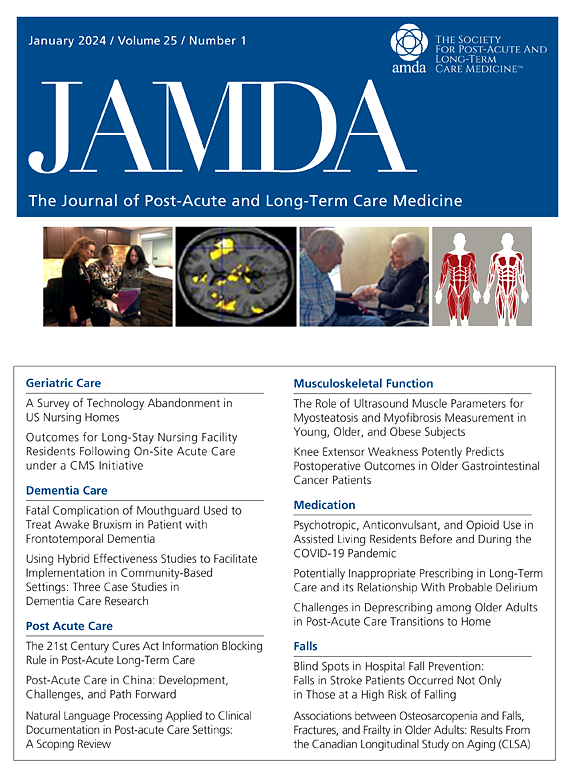Physician Health Counseling for Older Adults with Obesity in the United States, 2015-2019: An Analysis of Repeated Cross-Sectional Data
IF 4.2
2区 医学
Q2 GERIATRICS & GERONTOLOGY
Journal of the American Medical Directors Association
Pub Date : 2025-05-30
DOI:10.1016/j.jamda.2025.105628
引用次数: 0
Abstract
Objectives
Obesity affects one-third of American adults aged ≥65 years. Despite the increasing uptake of prescription weight loss medications, physician provision of diet and exercise weight loss counseling and referrals benefits patients and improves health outcomes. To increase awareness about possible underuse of physician weight loss counseling and referrals, we used nationally representative data to examine their rates in older adults with obesity.
Design
Retrospective cross-sectional analysis of publicly available data from National Ambulatory Medical Care Survey from January 1, 2015, through December 31, 2019.
Setting and Participants
Adults aged ≥65 years with obesity, as defined by a body mass index (BMI) of 30 or higher.
Methods
Primary outcomes were prevalence of obesity diagnosis and type of physician behavioral counseling provided to older patients. Data were analyzed using Poisson regression.
Results
Between 2015 and 2019, American adults aged ≥65 years made approximately 301 million physician office visits annually, and height and weight data were available for BMI estimation in 65.2% of visits. Among these visits, 35.3% were for patients with BMI ≥30 and 29.4% had a diagnosis of obesity during the visit. The prevalence of health counseling for obesity was low and ranged from 7.9% for weight reduction counseling to 18.7% for diet counseling. In adjusted analyses, patients aged ≥75 years were less likely to receive weight reduction counseling than patients aged 65-74 years. Women were less likely to receive weight reduction counseling than men. Having a diagnosis of obesity and seeing a primary care physician were both associated with increased likelihood of receiving weight reduction, diet, and exercise counseling. Antiobesity medication was prescribed in <1% of visits.
Conclusions and Implications
Despite a high prevalence of obesity among older adults in the United States, physicians underdiagnose these patients and often do not provide them with obesity-related health counseling. Substantial opportunities exist to improve the care of older adults with obesity who face an increased risk of obesity-related chronic disease and physical disability.
2015-2019年美国老年肥胖患者的医师健康咨询:重复横断面数据分析
目的:肥胖影响三分之一的65岁以上的美国成年人。尽管越来越多的人服用处方减肥药,但医生提供的饮食和运动减肥咨询和转诊对患者有益,并改善了健康结果。为了提高人们对医生减肥咨询和转诊可能使用不足的认识,我们使用了具有全国代表性的数据来检查老年人肥胖的发生率。设计:对2015年1月1日至2019年12月31日全国门诊医疗调查公开数据进行回顾性横断面分析。环境和参与者:年龄≥65岁的肥胖成年人,体重指数(BMI)为30或更高。方法:主要结局是肥胖诊断的患病率和向老年患者提供的医师行为咨询类型。数据采用泊松回归分析。结果:在2015年至2019年期间,年龄≥65岁的美国成年人每年约有3.01亿次就诊,其中65.2%的就诊可用于BMI估计的身高和体重数据。在这些就诊中,BMI≥30的患者占35.3%,29.4%的患者在就诊期间被诊断为肥胖。肥胖健康咨询的患病率较低,减肥咨询的患病率为7.9%,饮食咨询的患病率为18.7%。在调整分析中,年龄≥75岁的患者接受减肥咨询的可能性低于65-74岁的患者。女性接受减肥咨询的可能性低于男性。被诊断为肥胖和看初级保健医生都与接受减肥、饮食和运动咨询的可能性增加有关。结论和启示:尽管美国老年人中肥胖的患病率很高,但医生对这些患者的诊断不足,而且通常不向他们提供与肥胖相关的健康咨询。对于面临与肥胖相关的慢性疾病和身体残疾风险增加的老年肥胖患者,改善护理存在大量机会。
本文章由计算机程序翻译,如有差异,请以英文原文为准。
求助全文
约1分钟内获得全文
求助全文
来源期刊
CiteScore
11.10
自引率
6.60%
发文量
472
审稿时长
44 days
期刊介绍:
JAMDA, the official journal of AMDA - The Society for Post-Acute and Long-Term Care Medicine, is a leading peer-reviewed publication that offers practical information and research geared towards healthcare professionals in the post-acute and long-term care fields. It is also a valuable resource for policy-makers, organizational leaders, educators, and advocates.
The journal provides essential information for various healthcare professionals such as medical directors, attending physicians, nurses, consultant pharmacists, geriatric psychiatrists, nurse practitioners, physician assistants, physical and occupational therapists, social workers, and others involved in providing, overseeing, and promoting quality

 求助内容:
求助内容: 应助结果提醒方式:
应助结果提醒方式:


